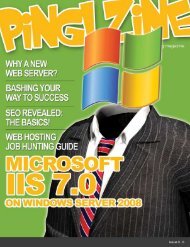bits & bytes - Ping! Zine Web Tech Magazine
bits & bytes - Ping! Zine Web Tech Magazine
bits & bytes - Ping! Zine Web Tech Magazine
You also want an ePaper? Increase the reach of your titles
YUMPU automatically turns print PDFs into web optimized ePapers that Google loves.
likely move to the most expensive<br />
Non-Qualified category, regardless of<br />
whether it was swiped or hand-keyed<br />
by the cashier.<br />
Step 2: Understand how these rates<br />
work with your business.<br />
Because most of you reading<br />
this article are probably not selling<br />
hockey sticks in a retail environment,<br />
it is worthwhile to review how these<br />
rate categories affect internet based<br />
transactions.<br />
The first thing to understand is that<br />
processing rates are generally higher<br />
for an internet merchant than for a<br />
merchant that swipes all transactions.<br />
Typically, internet transactions are<br />
classified as Mid-Qualified in the case<br />
of consumer cards, or non-qualified if<br />
they are reward program or corporate<br />
cards. So, if you do not swipe credit<br />
cards in a face-to-face setting, and<br />
someone is trying to sell you on a<br />
1.64% Qualified rate, you’re probably<br />
best to run away, because very few (if<br />
any) of your transactions will be in this<br />
rate category!<br />
Unfortunately, a great many<br />
merchants are lured with low Qualified<br />
rates, while the Mid-Qualified and<br />
Non-Qualified rates are significantly<br />
higher. To avoid surprises on your<br />
monthly merchant statement, it’s<br />
critical that you understand all possible<br />
rate categories and how your processor<br />
will classify transactions.<br />
Once you are satisfied with your<br />
Mid-Qualified and Non-Qualified<br />
processing programs, you want to<br />
ensure that you receive the decreased<br />
cost for “offline” debit transactions. As<br />
we stated earlier, Visa and MasterCard<br />
lowered the costs for these rates,<br />
however most processors are not<br />
passing the savings to the merchant.<br />
This is particularly distressing in light<br />
of our research – we have found that<br />
the average hosting company accepts<br />
internet debit payments for as much as<br />
thirty percent of their overall business.<br />
Moreover, after having seen hundreds<br />
of credit card processing statements<br />
specifically from hosting companies,<br />
we can report that only a handful<br />
of them have had the Internet debit<br />
rate correctly segregated, and even<br />
fewer have had the appropriate cost<br />
associated. Thus, leveraging the new<br />
rate structure can almost always have<br />
a very positive impact on your bottom<br />
line.<br />
Step 3: Make the new debit rate<br />
work for you.<br />
The easiest way to confirm that you<br />
are receiving the decreased cost for<br />
debit sales is to review your monthly<br />
merchant statement. The debit rate<br />
should be identified as a separate<br />
category, and be billed at a lower rate<br />
than your other sales. One still needs<br />
to be cautious, however! We have seen<br />
numerous advertisements and emails<br />
trying to lure in companies, by offering<br />
a low two-tiered plan. In other words,<br />
they offer a median priced Qualified<br />
and Non-Qualified rate, but they are<br />
not reporting a Mid-Qualified or Debit<br />
rate. In cases like this, the processor<br />
is capitalizing on your debit sales<br />
as opposed to passing the additional<br />
savings on to your business.<br />
To avoid the problems of a two-tiered<br />
system, be sure that you work with a<br />
three-tiered program: one that provides<br />
you the cost for a Debit transaction, a<br />
Mid-Qualified transaction, and a Non-<br />
Qualified transaction.<br />
To view a few examples of<br />
competitive debit rate programs being<br />
offered in this hosting industry, visit<br />
either 1) ModernAuthorize at http://<br />
www.modernauthorize.com (Click<br />
on the American flag) or 2) SWsoft<br />
at http://www.bluepay.com/landings/<br />
swsoft/programSWsoft.html<br />
Step 4: Make sure you are partnering<br />
with the right providers.<br />
Akin to almost any product you<br />
purchase for your business, the closer<br />
you get to the source, the lower your<br />
transaction processing cost will<br />
be. Unfortunately, many hosting<br />
companies purchase their payment<br />
processing services from sales agents<br />
and/or resellers that may be three or<br />
four levels down from the source.<br />
That means your business is filling<br />
the pockets of those independent sales<br />
agents, as opposed to building your<br />
bottom line.<br />
It can thus be very valuable to find out<br />
from who you purchase your payment<br />
gateway and merchant account. If you<br />
are not buying from the source (i.e.<br />
the direct merchant account provider<br />
and the author/development company<br />
behind the payment gateway), it may<br />
be time to look for another provider.<br />
By taking this step, you will inevitably<br />
be able to save on your processing<br />
costs. P!<br />
PING! ZINE WRITER BIO<br />
BluePay is a market-leading provider of direct payment processing<br />
solutions. With a focus on the ISP and Hosting markets, BluePay<br />
offers some of the most cost effective payment processing<br />
solutions available today. In addition, BluePay can customize<br />
their payment gateway to address any payment-processing<br />
environment. You can contact BluePay at http://www.bluepay.<br />
com or toll free at 866-613-5422.<br />
www.pingzine.com 53
















